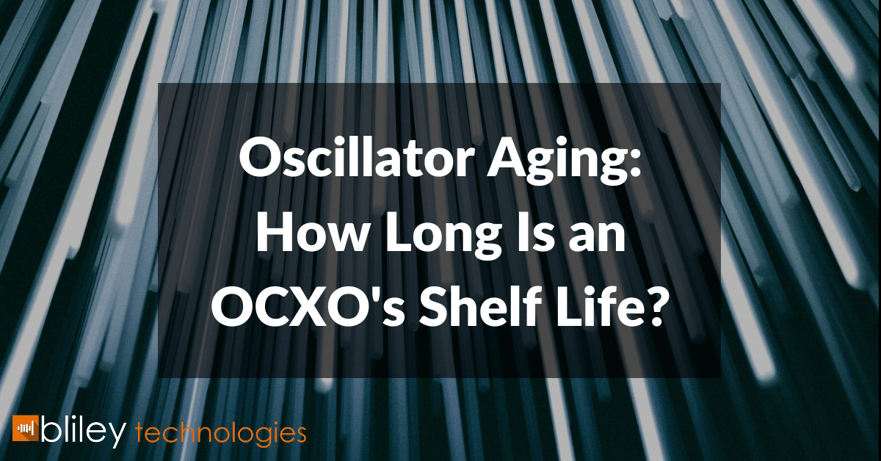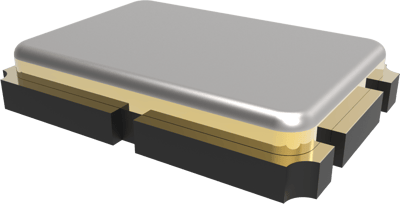
We’re often asked if it’s wise to purchase crystal oscillators in large batches, especially when commodity managers are aware all the oscillators might not be used right away.
By nature, crystal oscillators are made of natural quartz material, which gives them a very long shelf life. In this article, we’ll take a look at why that is and how the stability of crystal oscillators gives them an indefinite shelf life.
What Are Crystal Oscillators (XOs) and Oven-Controlled Crystal Oscillators (OCXOs)?
A crystal oscillator is an integrated electronic circuit that uses a thin slice of quartz crystal as the frequency-selective element. The quartz crystal vibrates at a certain stable, resonant frequency. It operates at this frequency when a small voltage is applied to it, causing it to deform slightly but predictably. When the voltage is removed, the crystal returns to its original shape, and no longer causes an oscillation at the prescribed frequency.
An Oven-Controlled Crystal Oscillator (OCXO) is a more stable crystal oscillator. Because temperature changes the size and shape of the crystal, temperature also impacts the resonant frequency. An OCXO has a tight temperature control loop that heats a tiny furnace around the crystal to ensure it always operates at the same temperature. This increases the stability of the frequency.
How Are OCXOs Used?
The slice of quartz is cut so that its resonant frequency is known, and when a voltage is applied, it will vibrate at the exact same frequency every time. This is why clocks, radios, and other objects that require precise timing or frequency often employ a crystal oscillator.
High frequency electronics often rely on stable frequency sources for mixing, sampling, and similar operations. Consider the radio transmitter in your smartphone that takes your voice and transmits it to a cellular phone tower. The frequencies your voice generates will only travel a little way before the air attenuates them. Instead, they are converted to a radio wave that can travel much farther.
In order for this conversion to take place, the signal from the microphone is mixed with a specific frequency from a “local oscillator.” The purpose of the local oscillator is to provide a frequency-stable source that will mix with your voice consistently. It must also be predictable so the receiver on the other end can de-mix the signal and separate out your voice without any distortion.
Ideal mixer. The input signal could be your voice, the local oscillator is often a crystal, and the output signal is a radio wave that contains your voice’s information and a carrier wave. Image source: By Jarmokivekas - Own work, CC BY-SA 3.0, Wikipedia Commons.
One common method of making a frequency-stable, local oscillator is to use a crystal oscillator.

Bliley's BQCSA series crystal oscillator.
What Drives a Crystal Oscillator's Shelf Life?
Crystal oscillators and OCXOs are incredibly stable throughout their lifetimes. While it’s generally accepted that electronic components have a two-year shelf life, crystal oscillators last longer. The crystal itself has a very long life due to the fact that the circuit contains no moving parts, is not deforming significantly during operation, and is chemically inert. The circuit that uses the crystal, as well as the furnace and control circuit for the OCXO, are also made from high-quality components and also have a long life.
Quartz and other materials used in crystal oscillators are inert minerals, meaning it takes thousands of years to weather them in nature – giving them an indefinite shelf life. In an electronic device, these crystals are virtually immune to damage from corrosion, moisture, and other environmental contaminants. The slice of quartz is also dense, meaning it has very little pore space for mold and fungi to spawn.
The crystal oscillator circuit and the OCXO circuits are tested to MIL Standards and/or AEC-Q200, which is an automotive stress test for electrical components. A component that is designed to survive these qualifications will have a long shelf life, as these qualifications were designed for all-weather, under-the-hood use.
Included in this test are electrical, thermal, mechanical vibration, and physical shock tests, as well as chemical and moisture exposure tests. For example, components used in an OCXO are rated to an operating temperature range of -55°C to 125°C, which is significantly higher than standard electronic components, which may only be rated from 40°C to 60°C.
Shelf Life of Crystal Oscillators Over Time
Quartz ages in a predictable manner, where its resonant frequency changes over time. Their aging is not linear, changing more rapidly in their early days, but changing much more slowly later in life. Because of this, some components are pre-aged slightly to ensure their resonant frequency is more stable over their lifetime.
Ideally, OCXO circuits will have the power applied at all times, but components stored on a shelf or installed on equipment that has been unplugged will not have such a luxury. For the OCXO, this is not a concern. Thanks to a phenomenon called “retracing,” the quartz retraces and begins aging right where it left off when power resumes.
The predictability of the aging means OXCOs can be constructed that resonate at a slightly different frequency. When these age, the resonant frequency will drift predictably.
Bottom Line: The Shelf Life of an OCXO Isn’t a Concern
Perhaps one of the most important features of crystal oscillators is that they remain predictable and stable over time over very high operating temperature ranges. Shelf life in crystal oscillators is rarely a concern, as storage temperatures are well below the operating requirements of the designed devices. It’s very safe to purchase them in large batches and secure the benefits of pricing and lead time relief within your program/product life cycle.
This means a crystal oscillator, whether it’s placed in a device or sitting in a warehouse and waiting to be used, will likely oscillate at the appropriate frequency for many years to come.
Learn more about Bliley’s high-performance crystal oscillators or download our free guide, An Introduction to Common Oscillator Types.





